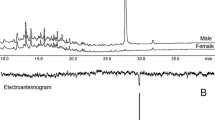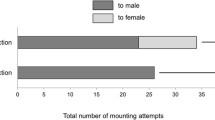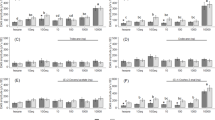Abstract
The ability of stink bugs to release high amounts of strong-smelling and irritating defensive compounds is related to their metathoracic gland (MTG), which is an exocrine gland with defensive, sexual, alarm and aggregation signal functions. Orsilochides leucoptera (Scutelleridae) is a widespread species in the Neotropical region that feeds on plants of the families Malvaceae, Poaceae and Euphorbiaceae. A series of compounds (ketones, alcohols and esters) have been identified in the MTGs among the three species of Scutelleridae whose MTG secretions have been investigated thus far; however, no sex pheromone compounds have been described for any scutellerid species. The aim of this work was to study sex pheromone communication within this family of stink bugs, and identify the compounds present in the MTG of O. leucoptera. Analysis by gas chromatography/mass spectrometry (GC/MS) revealed two male specific compounds identified as (R)-camphor (1) and (R)-borneol (2), which were attractive to females in Y-tube olfactometer bioassays. Also, GC/MS analysis of secretions from MTG of males and females of O. leucoptera, identified eight additional compounds: 2-(E)-hexenal (3), (E)-4-oxo-2-hexenal (4), (E)-hex-2-enyl acetate (5), (R)-linalool (6), (R)-α-terpineol (7), dodecane (8), 1-tridecene (9) and n-tridecane (10). From these, (R)-α-terpineol was detected only in the gland of males, and is probably a biosynthetic intermediate of the pheromone components. Most of the MTG compounds identified in O. leucoptera have been identified in other heteropteran species. Camphor is often a toxic and repellent compound for insects. However, we report it, for the first time, as a sex pheromone component of an insect.





Similar content being viewed by others
References
Abad RFP, Azhari S, Djozan D, Hejazi MJ (2012) Compounds in abdominal and metathoracic scent glands of nymphs and adults of Graphosoma lineatum (Linnaeus, 1758) (Het., Scutelleridae) under laboratory conditions. Mun Ent Zool 7:870–880
Acosta LG, Jahnke SM, Redaelli LR, Pires PRS (2017) Insect diversity in organic rice fields under two management systems of levees vegetation. Braz J Biol 77:731–744
Aldrich JR, Lusby R, Kochansky WP, Abrams JC (1984) Volatile compounds from the predatory insect Podisus maculiventris (Hemiptera: Pentatomidae): Male and female metathoracic scent gland and female dorsal abdominal gland secretions. J Chem Ecol 10:561–568
Aldrich JR (1988) Chemical ecology of the Heteroptera. Annu Rev Entomol 33:211–238
Aldrich JR, Leal WS, Nishida R, Khrimian AP, Lee CJ, Sakuratani Y (1997) Semiochemistry of aposematic seed bugs. Entomol Exp Appl 84:127–135
Aldrich JR, Oliver JE, Taghizadeh T, Ferreira JTB, Liewehr D (1999) Pheromones and colonization: Reassessment of the milkweed bug migration model (Heteroptera: Lygaeidae: Lygaeinae). Chemoecol 9:63–71
Aldrich JR, Zhang A, Oliver JE (2000) Attractant pheromone and allomone from the metathoracic scent gland of a broad-headed bug (Hemiptera: Alydidae). Can Entomol 132:915–923
Ambrogi BG, Zarbin PHG (2008) Aggregation pheromone in Sternechus subsignatus (Coleoptera: Curculionidae): olfactory behavior and temporal pattern of emission. J Appl Entomol 132:54–58
Arakaki N, Shimoji Y, Wakamura S (2009) Camphor: An attractant for the cupreous polished chafer, Protaetia pryeri pryeri (Janson) (Coleoptera: Scarabaeidae). Appl Entomol Zool 44:621–625
Banthorpe DV, Charlwood BV, Francis MJO (1972) The biosynthesis of monoterpenes. Chem Rev 72:115–155
Calam DH, Youdeowei A (1968) Identification and functions of secretion from the posterior scent gland of fifth instar larva of the bug Dysdercus intermedius. J Insect Physiol 14:1147–1158
Donkin RA (1999) Dragon’s Brain Perfume – An Historical Geography of Camphor. Brill, Leiden, p 307
Durak D, Kalender Y (2007) Fine structure and chemical analysis of the metathoracic scent gland of Eurygaster maura (Linnaeus, 1758) (Heteroptera: Scutelleridae). Folia Biol 55:133–141
Eger JE, Barcellos A, Weiler L (2015) Shield bugs (Scutelleridae). In: Panizzi AR, Grazia J (eds) True bugs (Heteroptera) of the Neotropics. Springer-Dordrecht, pp 757–788
Fávaro CF, Rodrigues MACM, Aldrich JR, Zarbin PHG (2011) Identification of semiochemicals in sdults and symphs of the stink bug Pallantia macunaima Grazia (Hemiptera: Pentatomidae). J Braz Chem Soc 22:58–64
Fávaro CF, Santos TB, Zarbin PHG (2012) Defensive compounds and male-specific sex pheromone of the stink bug, Agroecus griseus. J Chem Ecol 38:1124–1132
Fávaro CF, Zarbin PHG (2013) Identification of (Z)-4- and 1-Tridecene in the metathoracic gland secretions of stink bugs employing the GC/FT-IR technique. J Chem Ecol 39:1182–1185
Feldlaufer MF, Domingue MJ, Chauhan KR, Aldrich JR (2010) 4-oxo-Aldehydes from the dorsal abdominal glands of the bed bug (Hemiptera: Cimicidae). J Med Entomol 47:140–143
Hassani H, Abad RFP, Djozan D, Fazel MM (2010) Compounds in metathoracic glands of adults of the sunn pest, Eurygaster integriceps (Puton) (Heteroptera: Scutelleridae). Mun. Ent Zool 5:232–239
Inoue KM, Vidal DM, Saad EB, Martins CBC, Zarbin PHG (2019) Identification of the alarm and sex pheromones of the leaf-footed bug, Leptoglossus zonatus (Heteroptera: Coreidae). J Braz Chem Soc 30:939–947
Javahery MCW, Schaefer JDL (2000) Shield bugs (Scutelleridae). In: Schaefer CW, Panizzi AR (eds) Heteroptera of Economic Importance. CRC, Boca Raton, pp 475–503
Leal WS, Higughi H, Mizutani N, Nakamori H, Kadosawa T, Ono M (1995) Multifunctional communication in Riptortus clavatus (Heteroptera: Alydidae): Conspecific nymphs and egg parasitoid Ooencyrtus nezarae use the same adult attractant pheromone as chemical cue. J Chem Ecol 21:973–985
Leal WS, Ueda Y, Ono M (1996) Attractant pheromone for male rice bug, Leptocorisa chinensis: Semiochemicals produced by both male and female. J Chem Ecol 22:1429–1437
Leal WS, Zarbin PHG, Wojtasek H, Ferreira JT (1999) Biosynthesis of scarab beetle pheromones – Enantioselective 8-hydroxylation of fatty acids. Eur J Biochem 259:175–180
Martins CBC, Zarbin PHG (2013) Volatile organic compounds of conspecific-damaged Eucalyptus benthamii influence responses of mated females of Thaumastocoris peregrinus. J Chem Ecol 39:602–611
Millar JG, Rice RE, Wang Q (1997) Sex pheromone of the mirid bug Phytocoris relativus. J Chem Ecol 23:1743–1754
Millar JG, McBrien HL, Ho HY, Rice RE, Cullen E, Zalom FG, Uokl A (2002) Pentatomid bug pheromones in IPM: possible applications and limitations. IOBC Bull 25:1–11
Millar JG (2005) Pheromones of true bugs. Top Curr Chem 240:37–84
Moraes MCB, Pareja M, Laumann RA, Borges M (2008) The chemical volatiles (Semiochemicals) produced by neotropical stink bugs (Hemiptera: Pentatomidae). Neotrop Entomol 37:489–505
Nasipuri D, Samaddar AK, Gupta MD (1993) Asymmetric reduction of carbonyl compounds with chiral alkoxyaluminium and alkoxymagnesium halides: an overview. Proc. Indian Acad. Sci. 93(4):601–614
Pattenden G, Staddon BW (1970) Observations of the metasternal scent glands of Lethocerus spp. (Hem: Het: Belostomatidae) Ann Entomol Soc Amer 63:900–901
Prudic KL, Noge K, Becerra JX (2008) Adults and nymphs do not smell the same: The different defensive compounds of the giant mesquite bug (Thasus neocalifornicus: Coreidae). J Chem Ecol 34:734–741
Smith RF, Pierce JR, Borden HD JH (1991) Sex pheromone of the mullein bug, Campylomma verbasci (Meyer) (Heteroptera: Miridae). J Chem Ecol 17:1437–1447
Staddon BW (1979) The scent glands of Heteroptera. Adv Insect Physiol 14:351–418
Soldi RA, Rodrigues MACD, Aldrich JR, Zarbin PHG (2012) The sex pheromone of the true bug Phthia picta (Heteroptera: Coreidae) is an unusual hydrocarbon. J Chem Ecol 38:814–824
Vandendool H, Kratz PD (1963) A generalization of retention index system including linear temperature programmed gas-liquid partition chromatography. J Chromatogr A 11:463–471
Watanabe K, Shimizu N (2017) Identification of a sex pheromone of the chrysanthemum lace bug Corythucha marmorata (Hemiptera: Tingidae). Sci Rep 7:7302
Zarbin PHG, Ferreira JTB, Leal WS (1999) Metodologias gerais empregadas no isolamento e identificação estrutural de feromônios de insetos. Quím Nova 22:263–268
Zarbin PHG, Borges M, Santos AA, Oliveira ARM, Simonelli F, Marques FA (2000) Alarm Pheromone system of stink bug Piezodorus guildinii (Heteroptera: Pentatomidae). J Braz Chem Soc 11:424–428
Zhang QH, Aldrich JR (2003) Pheromones of milkweed bugs (Heteroptera: Lygaeidae) attract wayward plant bugs: Phytocoris mirid sex pheromone. J Chem Ecol 29:1835–1851
Zhang QH, Aldrich JR (2008) Sex pheromone of the plant bug. Phytocoris calli Knight J Chem Ecol 34:719–724
Acknowledgements
Financial support from Coordenação de Aperfeiçoamento de Pessoal de Nível Superior (CAPES), Conselho Nacional de Desenvolvimento Científico e Tecnológico (CNPq) and Instituto Nacional de Ciência e Tecnologia (INCT) de Semioquímicos na Agricultura.
Author information
Authors and Affiliations
Corresponding author
Electronic supplementary material
ESM 1
(DOCX 1090 kb)
Rights and permissions
About this article
Cite this article
de Melo, D.J., da Silva, M.R., Moliterno, A.A.C. et al. Camphor and Borneol as the Male-Produced Sex Pheromone of the Shield Bug, Orsilochides leucoptera (Hemiptera: Scutelleridae). J Chem Ecol 46, 490–496 (2020). https://doi.org/10.1007/s10886-020-01189-z
Received:
Revised:
Accepted:
Published:
Issue Date:
DOI: https://doi.org/10.1007/s10886-020-01189-z




